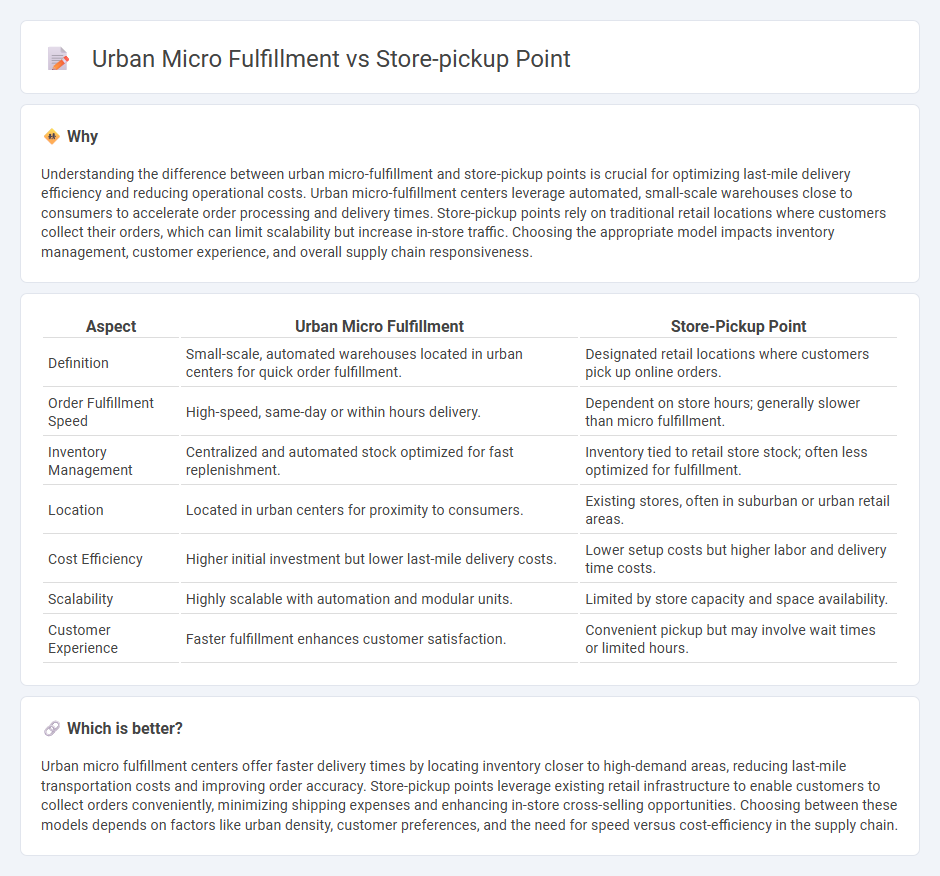
Urban micro fulfillment centers optimize last-mile delivery by strategically placing small warehouses within city limits, reducing delivery times and operational costs. Store-pickup points leverage existing retail locations to enable customers to collect orders conveniently, minimizing shipping expenses and enhancing customer experience. Explore how these models transform urban logistics and shape the future of e-commerce fulfillment.
Why it is important
Understanding the difference between urban micro-fulfillment and store-pickup points is crucial for optimizing last-mile delivery efficiency and reducing operational costs. Urban micro-fulfillment centers leverage automated, small-scale warehouses close to consumers to accelerate order processing and delivery times. Store-pickup points rely on traditional retail locations where customers collect their orders, which can limit scalability but increase in-store traffic. Choosing the appropriate model impacts inventory management, customer experience, and overall supply chain responsiveness.
Comparison Table
| Aspect | Urban Micro Fulfillment | Store-Pickup Point |
|---|---|---|
| Definition | Small-scale, automated warehouses located in urban centers for quick order fulfillment. | Designated retail locations where customers pick up online orders. |
| Order Fulfillment Speed | High-speed, same-day or within hours delivery. | Dependent on store hours; generally slower than micro fulfillment. |
| Inventory Management | Centralized and automated stock optimized for fast replenishment. | Inventory tied to retail store stock; often less optimized for fulfillment. |
| Location | Located in urban centers for proximity to consumers. | Existing stores, often in suburban or urban retail areas. |
| Cost Efficiency | Higher initial investment but lower last-mile delivery costs. | Lower setup costs but higher labor and delivery time costs. |
| Scalability | Highly scalable with automation and modular units. | Limited by store capacity and space availability. |
| Customer Experience | Faster fulfillment enhances customer satisfaction. | Convenient pickup but may involve wait times or limited hours. |
Which is better?
Urban micro fulfillment centers offer faster delivery times by locating inventory closer to high-demand areas, reducing last-mile transportation costs and improving order accuracy. Store-pickup points leverage existing retail infrastructure to enable customers to collect orders conveniently, minimizing shipping expenses and enhancing in-store cross-selling opportunities. Choosing between these models depends on factors like urban density, customer preferences, and the need for speed versus cost-efficiency in the supply chain.
Connection
Urban micro fulfillment centers enhance logistics efficiency by enabling faster order processing and inventory management within densely populated areas. Store-pickup points serve as accessible distribution hubs where customers can conveniently collect online orders, reducing last-mile delivery challenges. The integration of these systems streamlines supply chains, lowers delivery costs, and improves urban accessibility to goods.
Key Terms
Store-Pickup Point:
Store-pickup points serve as strategic retail locations allowing customers to collect online orders quickly, reducing last-mile delivery costs and improving convenience. These points integrate inventory management with physical stores, enabling faster order fulfillment and enhancing customer satisfaction through immediate access to goods. Explore how store-pickup points revolutionize urban retail logistics and boost omnichannel shopping experiences.
Click-and-Collect
Store-pickup points provide customers with designated locations to retrieve online orders, enhancing convenience and reducing delivery times. Urban micro fulfillment centers are strategically placed small-scale warehouses that enable faster last-mile delivery within dense city areas, optimizing inventory management for Click-and-Collect services. Explore the advantages of each method to determine the best strategy for your e-commerce fulfillment needs.
In-Store Inventory
In-store inventory plays a crucial role in both store-pickup points and urban micro fulfillment centers, enabling faster order processing and reduced delivery times. Store-pickup points leverage existing retail spaces to allow customers immediate product access, while urban micro fulfillment centers optimize inventory layout for efficient order assembly within dense city areas. Discover how maximizing in-store inventory can enhance your omnichannel fulfillment strategy.
Source and External Links
Best Buy Store Pickup - Store Pickup allows you to order online, select a store for pickup, receive a "Ready for pickup" email, then bring your ID and order number to the store; items are held for 5 days and can be picked up by you or someone you authorize during checkout.
Order Online & Pick up in 20 minutes - Office Depot - You can buy online and pick up at the store or curbside, usually ready in 20 minutes with email alerts, plus options like reserved parking and free in-store or curbside pickup.
Free In Store & Curbside Pickup | Barnes & Noble(r) - Offers free in-store and curbside pickup by ordering or reserving online with notifications when your order is ready; payment can be made online or in store at pickup with a photo ID required.
 dowidth.com
dowidth.com